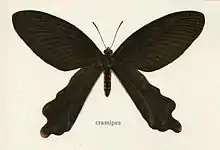Byasa crassipes
Byasa crassipes, the black windmill, is a butterfly found in India and Southeast Asia that belongs to the windmills genus, Byasa, comprising tailed black swallowtail butterflies with white spots and red submarginal crescents.
| Black windmill | |
|---|---|
 | |
| Scientific classification | |
| Domain: | Eukaryota |
| Kingdom: | Animalia |
| Phylum: | Arthropoda |
| Class: | Insecta |
| Order: | Lepidoptera |
| Family: | Papilionidae |
| Genus: | Byasa |
| Species: | B. crassipes |
| Binomial name | |
| Byasa crassipes | |
Range
Northeast India (Manipur), Myanmar (southern Shan states), northern Thailand, northern Laos, northern Vietnam (Tonkin), and possibly southern China.[2]
Status
The black windmill is very rare and is protected by law in India. More information is required on this species.
Description
The wingspan is 110–120 mm. It is a black butterfly which is unmarked except for obscure red spots on the upper hindwing. The tail is red tipped below.
Male upperside: Forewing dark fuliginous (sooty) black, with black veins, a longitudinal streak between the veins and streaks within the cell. Hindwing very narrow anteriorly and much prolonged posteriorly, exterior margin broadly scalloped, tail very broad and short; abdominal margin with a very long folded lappet, which when opened displays a lengthened greyish-white woolly androconial patch; colour dull greyish black, with two upper marginal and two sub-anal lunules, tip of the tail very obscure dusky red. Underside: forewing paler. Hindwing dull black, with the two upper and lower marginal lunules, an irregular-shaped anal lunule, and the tail tip bright crimson. Thorax and abdomen above black; front of head and thorax and abdomen beneath crimson; abdomen beneath with black segmental bands; hind tibiae very thick; antennae and legs black.[3]
Taxonomy
No separate subspecies have been described.
Habits
Recorded from Manipur between 1,000 and 2,500 ft (300 and 760 m).
References
- Häuser, Christoph L.; de Jong, Rienk; Lamas, Gerardo; Robbins, Robert K.; Smith, Campbell; Vane-Wright, Richard I. (28 July 2005). "Papilionidae – revised GloBIS/GART species checklist (2nd draft)". Entomological Data Information System. Staatliches Museum für Naturkunde Stuttgart, Germany. Archived from the original on 9 September 2010. Retrieved 21 June 2013.
- Philip Lo (Kadoorie Farm and Botanic Garden, Hong Kong); International), Eresha Fernando (BirdLife; Moonen, Jan; Kehimkar, Isaac; Jangid, Ashish (2019-02-28). "IUCN Red List of Threatened Species: Byasa crassipes". IUCN Red List of Threatened Species. doi:10.2305/iucn.uk.2020-3.rlts.t121971897a176105416.en. Retrieved 2021-05-20.
- Bingham, C.T. (1907). The Fauna of British India, Including Ceylon and Burma. Vol. II (1st ed.). London: Taylor and Francis, Ltd.
- Collins, N. Mark; Morris, Michael G. (1985). Threatened Swallowtail Butterflies of the World: The IUCN Red Data Book. Gland & Cambridge: IUCN. ISBN 978-2-88032-603-6 – via Biodiversity Heritage Library.
- Evans, W.H. (1932). The Identification of Indian Butterflies (2nd ed.). Mumbai, India: Bombay Natural History Society.
- Haribal, Meena (1992). The Butterflies of Sikkim Himalaya and Their Natural History. Gangtok, Sikkim, India: Sikkim Nature Conservation Foundation.
- Wynter-Blyth, Mark Alexander (1957). Butterflies of the Indian Region. Bombay, India: Bombay Natural History Society. ISBN 978-8170192329.